Related Research Articles

The Final Solution or the Final Solution to the Jewish Question was a Nazi plan for the genocide of individuals they defined as Jews during World War II. The "Final Solution to the Jewish question" was the official code name for the murder of all Jews within reach, which was not restricted to the European continent. This policy of deliberate and systematic genocide starting across German-occupied Europe was formulated in procedural and geopolitical terms by Nazi leadership in January 1942 at the Wannsee Conference held near Berlin, and culminated in the Holocaust, which saw the murder of 90% of Polish Jews, and two-thirds of the Jewish population of Europe.
Marcinkonys or Marcinkańce Ghetto was a small Jewish ghetto established during the Holocaust in Marcinkonys. It existed from around November 1941 to November 1942 and housed 300 to 400 Jews.
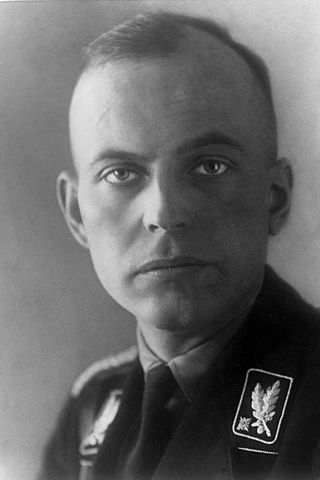
Hans-Adolf Prützmann was among the highest-ranking German SS officials during the Nazi era. From June 1941 to September 1944, he served as a Higher SS and Police Leader in the occupied Soviet Union, and from November 1943 was the Supreme SS and Police Leader in Ukraine. He oversaw the activities of the Einsatzgruppen detachments that perpetrated the Holocaust in the Baltic States and Ukraine. After being captured at the end of the Second World War, he committed suicide.

The Schutzmannschaft, or Auxiliary Police was the collaborationist auxiliary police of native policemen serving in those areas of the Soviet Union and the Baltic states occupied by Nazi Germany during World War II. Heinrich Himmler, head of the SS, established the Schutzmannschaft on 25 July 1941, and subordinated it to the Order Police. By the end of 1941, some 45,000 men served in Schutzmannschaft units, about half of them in the battalions. During 1942, Schutzmannschaften expanded to an estimated 300,000 men, with battalions accounting for about a third, or less than one half of the local force. Everywhere, local police far outnumbered the equivalent German personnel several times; in most places, the ratio of Germans to natives was about 1-to-10.
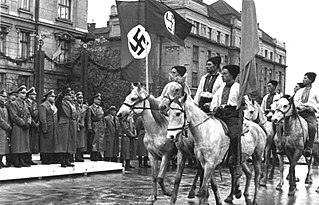
Ukrainian collaboration with Nazi Germany took place during the occupation of Poland and the Ukrainian SSR, USSR, by Nazi Germany during the Second World War.

Kraków District was one of the original four administrative districts set up by Nazi Germany after the German occupation of Poland during the years of 1939–1945. This district, along with the other three districts, formed the General Government. It was established on October 12, 1939 by Adolf Hitler, with the capital in occupied Kraków – the historic residence of Polish royalty. The Nazi Gauleiter Hans Frank became the Governor-General of the entire territory of the General Government. He made his residence in Kraków at the heavily guarded Wawel castle. Frank was the former legal counsel to the Nazi Party.
The Holocaust in Belarus refers to the systematic extermination of Jews living in the Byelorussian Soviet Socialist Republic during its occupation by Nazi Germany in World War II. It is estimated that roughly 800,000 Belarusian Jews were murdered during the Holocaust. However, other estimates place the number of Jews killed between 500,000 and 550,000.
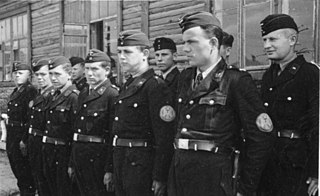
The Ukrainian Auxiliary Police was the official title of the local police formation set up by Nazi Germany during World War II in Eastern Galicia and Reichskommissariat Ukraine, shortly after the German occupation of the Western Ukrainian SSR in Operation Barbarossa.

The Belarusian Auxiliary Police was a German force established in July 1941 in occupied Belarus, staffed by local collaborators. In western Belarus, auxiliary police were formed in the form of Schutzmannschaften units, while in the east they were formed in the form of Ordnungsdienst.

The Holocaust in Ukraine was the systematic mass murder of Jews in the Reichskommissariat Ukraine, the General Government, the Crimean General Government and some areas which were located to the East of Reichskommissariat Ukraine, in the Transnistria Governorate and Bessarabia, Northern Bukovina and the Hertsa region and Carpathian Ruthenia during World War II. The listed areas are currently parts of Ukraine.

Dzisna is a town in Miory District, Vitebsk Region, in northern Belarus. It is located on the left bank of the Daugava River, near the confluence of the Dysna. Dzisna is located 133 kilometres (83 mi) northwest of Vitebsk. In 2017, its population was 1,500. As of 2024, it has a population of 1,386.
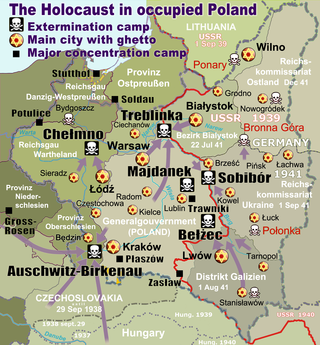
The Mizoch (Mizocz) Ghetto was a World War II ghetto set up in the town of Mizoch, [then Eastern Poland, today Western Ukraine] by Nazi Germany for the forcible segregation and mistreatment of Jews. On October 1942, Ukrainian Auxiliary Police and German policemen enclosed the ghetto; an uprising erupted, and the remaining inhabitants were mass murdered. Their execution has been photographed by the SS.

The Rovno Ghetto was a World War II Nazi ghetto established in December 1941 in the city of Rovno, western Ukraine, in the territory of German-administered Reichskommissariat Ukraine. On 6 November 1941, about 21,000 Jews were massacred by Einsatzgruppe C and their Ukrainian collaborators. The remaining Jews were imprisoned in the ghetto. In July 1942, the remaining 5,000 Jews were trucked to a stone quarry near Kostopol and murdered there.
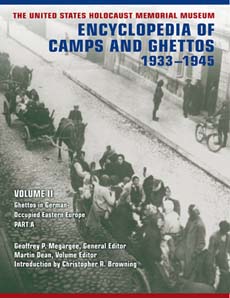
Encyclopedia of Camps and Ghettos, 1933–1945 is a seven-part encyclopedia series that explores the history of the concentration camps, ghettos, forced-labor camps, and other sites of detention, persecution, or state-sponsored murder run by Nazi Germany and other Axis powers in Europe and Africa. The series is produced by the United States Holocaust Memorial Museum (USHMM) and published by Indiana University Press. Research began in 2000; the first volume was published in 2009; and the final volume is slated for publication in 2025. Along with entries on individual sites, the encyclopedias also contain scholarly overviews for historical context.
During the German occupation of Poland, citizens of all its major ethnic groups collaborated with the Germans. Estimates of the number of collaborators vary. Collaboration in Poland was less institutionalized than in some other countries and has been described as marginal, a point of pride with the Polish people. During and after the war, the Polish government in exile and the Polish resistance movement punished collaborators and sentenced thousands of them to death.
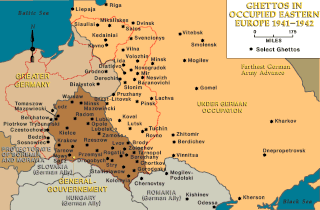
Brzesko Ghetto was a Nazi ghetto during World War II in occupied Poland. The ghetto was created by the Third Reich in 1941 in the Polish town of Brzesko located in the Kraków District about 40 miles from Kraków. The ghetto was open when it was first created. In 1942, walls were put up and the ghetto became a closed ghetto. An estimated 4,000 Jewish people lived there but another 2,000 moved there by 1942, many arriving from Kraków and the surrounding area. The Jewish people living within Brzesko were sent to the Bełżec extermination camp and Auschwitz extermination camp. After the exterminations, the camp was closed end of 1942.

Durchgangsstrasse IV was a road constructed by Nazi Germany in occupied Ukraine during World War II. It was a strategic military road to supply the southern sector of the Eastern Front. The large scale constructions works started in early 1942 to support the German advance towards Stalingrad. It ran for over 2,000 kilometres (1,200 mi) from Lviv east to Stalino. Organisation Todt was responsible for the construction which was sub-contracted to several private construction firms. It was constructed by forced laborers – Soviet prisoners of war, local civilians, and Jews – who were procured by the SS and guarded by the Schutzmannschaft battalions. One of the largest forced labor projects undertaken by Nazi Germany that involved Jewish labor, it marked a transition between using Jews as forced laborers to the practice of "extermination through labour".
References
- ↑ Dean, Martin Christopher (2022). "Forced Labor Camps for Jews in Reichskommissariat Ukraine: The Exploitation of Jewish Labor within the Holocaust in the East". Eastern European Holocaust Studies. 1: 175–196. doi: 10.1515/eehs-2022-0002 . ISSN 2749-9030.
- ↑ "LC Linked Data Service: Authorities and Vocabularies (Library of Congress)".
- ↑ "Confiscation of Jewish Property in Europe, 1933–1945: New Sources and Perspectives — United States Holocaust Memorial Museum". Ushmm.org. 22 March 2001. Retrieved 29 January 2016.
- ↑ Martin C. Dean (2010). Hayes, Peter; Roth, John K (eds.). Ghettos. Oxford Handbooks. doi:10.1093/oxfordhb/9780199211869.001.0001. ISBN 9780199211869.
- ↑ "Biographie de Martin C. Dean". Calmann-levy.fr. Retrieved 29 January 2016.
- ↑ Articles by Dean, M. C. (4 December 2015). "The German Gendarmerie, the Ukrainian Schutzmannschaft and the 'Second Wave' of Jewish Killings in Occupied Ukraine: German Policing at the Local Level in the Zhitomir Region, 1941-1944". German History. 14 (2). Gh.oxfordjournals.org: 168–192. doi:10.1093/gh/14.2.168.
- ↑ "Past Winners". Jewish Book Council. Retrieved 26 January 2020.